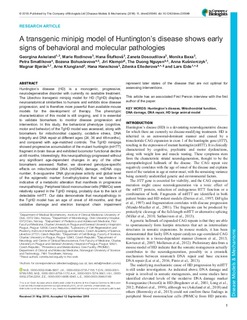| dc.contributor.author | Askeland, Georgina | |
| dc.contributor.author | Rodinova, Marie | |
| dc.contributor.author | Štufková, Hana | |
| dc.contributor.author | Dosoudilova, Zaneta | |
| dc.contributor.author | Baxa, Monika | |
| dc.contributor.author | Smatlikova, Petra | |
| dc.contributor.author | Bohuslavova, Bozena | |
| dc.contributor.author | Klempir, Jiri | |
| dc.contributor.author | Nguyen, The Duong | |
| dc.contributor.author | Kuśnierczyk, Anna | |
| dc.contributor.author | Bjørås, Magnar | |
| dc.contributor.author | Klungland, Arne | |
| dc.contributor.author | Hansikova, Hana | |
| dc.contributor.author | Ellederova, Zdenka | |
| dc.contributor.author | Eide, Lars | |
| dc.date.accessioned | 2019-01-09T12:39:59Z | |
| dc.date.available | 2019-01-09T12:39:59Z | |
| dc.date.created | 2018-12-05T09:51:17Z | |
| dc.date.issued | 2018 | |
| dc.identifier.citation | Disease Models and Mechanisms. 2018, 11 (10), . | nb_NO |
| dc.identifier.issn | 1754-8403 | |
| dc.identifier.uri | http://hdl.handle.net/11250/2579958 | |
| dc.description.abstract | Huntington's disease (HD) is a monogenic, progressive, neurodegenerative disorder with currently no available treatment. The Libechov transgenic minipig model for HD (TgHD) displays neuroanatomical similarities to humans and exhibits slow disease progression, and is therefore more powerful than available mouse models for the development of therapy. The phenotypic characterization of this model is still ongoing, and it is essential to validate biomarkers to monitor disease progression and intervention. In this study, the behavioral phenotype (cognitive, motor and behavior) of the TgHD model was assessed, along with biomarkers for mitochondrial capacity, oxidative stress, DNA integrity and DNA repair at different ages (24, 36 and 48 months), and compared with age-matched controls. The TgHD minipigs showed progressive accumulation of the mutant huntingtin (mHTT) fragment in brain tissue and exhibited locomotor functional decline at 48 months. Interestingly, this neuropathology progressed without any significant age-dependent changes in any of the other biomarkers assessed. Rather, we observed genotype-specific effects on mitochondrial DNA (mtDNA) damage, mtDNA copy number, 8-oxoguanine DNA glycosylase activity and global level of the epigenetic marker 5-methylcytosine that we believe is indicative of a metabolic alteration that manifests in progressive neuropathology. Peripheral blood mononuclear cells (PBMCs) were relatively spared in the TgHD minipig, probably due to the lack of detectable mHTT. Our data demonstrate that neuropathology in the TgHD model has an age of onset of 48 months, and that oxidative damage and electron transport chain impairment represent later states of the disease that are not optimal for assessing interventions. | nb_NO |
| dc.language.iso | eng | nb_NO |
| dc.publisher | Company of Biologists | nb_NO |
| dc.rights | Navngivelse 4.0 Internasjonal | * |
| dc.rights.uri | http://creativecommons.org/licenses/by/4.0/deed.no | * |
| dc.title | A transgenic minipig model of Huntington’s disease shows early signs of behavioral and molecular pathologies | nb_NO |
| dc.type | Journal article | nb_NO |
| dc.type | Peer reviewed | nb_NO |
| dc.description.version | publishedVersion | nb_NO |
| dc.source.pagenumber | 11 | nb_NO |
| dc.source.volume | 11 | nb_NO |
| dc.source.journal | Disease Models and Mechanisms | nb_NO |
| dc.source.issue | 10 | nb_NO |
| dc.identifier.doi | 10.1242/dmm.035949 | |
| dc.identifier.cristin | 1639299 | |
| dc.relation.project | Norges teknisk-naturvitenskapelige universitet: 46040500 | nb_NO |
| dc.description.localcode | This is an Open Access article distributed under the terms of the Creative Commons Attribution License (http://creativecommons.org/licenses/by/3.0), which permits unrestricted use, distribution and reproduction in any medium provided that the original work is properly attributed. | nb_NO |
| cristin.unitcode | 194,65,15,0 | |
| cristin.unitname | Institutt for klinisk og molekylær medisin | |
| cristin.ispublished | true | |
| cristin.fulltext | postprint | |
| cristin.qualitycode | 1 | |

